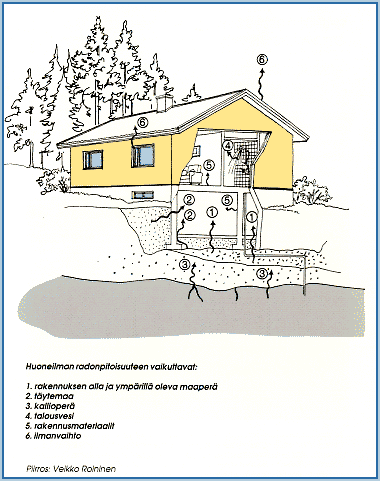Sources of radon
The pore air in the soil always contains high levels of radon. Radon-bearing air from the soil seeps into the building through openings and gaps in the base floor, due to underpressure in the building. This underpressure is caused by the temperature difference between outdoor and indoor air and mechanical ventilation. Thus, in winter the flow of radon-bearing air into the building is stronger than in summer. This means that radon concentrations in buildings are higher in winter than in summer.
In addition to soil, radon may release from rock and backfill under the building and from mineral-based materials in the base slab and load-bearing structures, such as concrete and lightweight concrete.
The uranium concentration in soil affects the radon concentration in the building. The higher the uranium level in soil in the area, the higher the radon concentrations found in buildings. In addition, the permeability of soil and backfill makes a difference: the coarser and more permeable the soil, the higher the radon concentrations. However, radon can be present anywhere in Finland and can only be detected by measurement.
Drinking water may contain radon
In Finland, radon is the radioactive substance contributing most to the radiation dose received from drinking water. When radon is swallowed in water, the stomach is exposed to a radiation dose. In addition, people are exposed to radon through inhalation, as radon readily evaporates into the air during the heating of water and also when taking a bath or a shower.
Building material
Building materials have the strongest effect on the radon concentration in buildings with a concrete frame. Walls, ceiling and floor made of concrete elements produce approximately a 70 Bq/m3 radon concentration in the building. In wooden low-rise residential buildings (i.e., detached, semi-detached and row houses) with only the floor slab made of concrete, the contribution of the concrete material in the slab is less than 20 Bq/m3.

Indoor air radon concentration is affected by: (1) the soil under and around the building; (2) the backfill; (3) the bedrock; (4) household water; (5) the building material; and (6) ventilation.
[email protected]